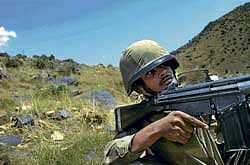Pak finds Taliban tough to root out

The bullet through his neck from a Taliban militant had narrowly missed an artery, and after some minor surgery, the army medics declared the patient, Sepoy Aziz, out of danger.
In an offensive nearly two years old, the Pakistani army has been fighting Taliban militants in the nation’s tribal areas and beyond, and like the US across the border in Afghanistan, it is finding counterinsurgency warfare tougher, and more costly, than anticipated.
Months after declaring victory on several important fronts, including in South Waziristan and the Swat Valley, the army has been forced to reopen campaigns after militants seeped back in. True victory remains elusive. Soldiers like Sepoy Aziz are killed and wounded almost daily.
Dragging campaign
Much like the challenge facing American and Nato forces in Afghanistan, an absence of Pakistani civilian authority has made it nearly impossible to consolidate military gains. While eliminating some Taliban insurgents, the campaign has dispersed many other fighters, forcing the army in effect to chase them from one part of the tribal areas to another.
As the campaign drags on, the Pakistani military relies more and more on American-supplied F-16 fighter jets and Cobra helicopter gunships to bomb militants in areas of treacherous terrain, increasing civilian casualties, according to reporters and Pakistani officials in the tribal areas.
Many of the Pakistani Taliban fighters organise and rest here in North Waziristan under the protection of Sirajuddin Haqqani, the Afghan Taliban leader who runs a network of several thousand fighters of his own.
Allied with the Taliban and backed by al-Qaeda, the Haqqani group makes up a significant part of the insurgency in Afghanistan, too, and American officials have pressed the army for an offensive against them. But for now the brunt of the effort against al-Qaeda and the Haqqani fighters is borne by US drone strikes launched with Pakistan’s acquiescence.
The Pakistani army says it is too overwhelmed tamping down the Taliban on other fronts in the tribal areas to take on a full-blown campaign in North Waziristan. There is truth to the Pakistani concern about being overstretched, American officials said.
But there are also deep suspicions that Pakistan’s military and intelligence service use Haqqani’s force to exert influence in Afghanistan, and keep India at bay.
Meanwhile, more than 2,000 troops have been killed in the last two years fighting the Pakistani Taliban, the military says. In South Waziristan, Taliban fighters operating in groups of 4 to 15 regularly hit Pakistani soldiers, army officers said. The Taliban use classic guerrilla tactics — sniper fire, roadside bombs, ambushes — and their innate knowledge of the terrain to great advantage, they said.